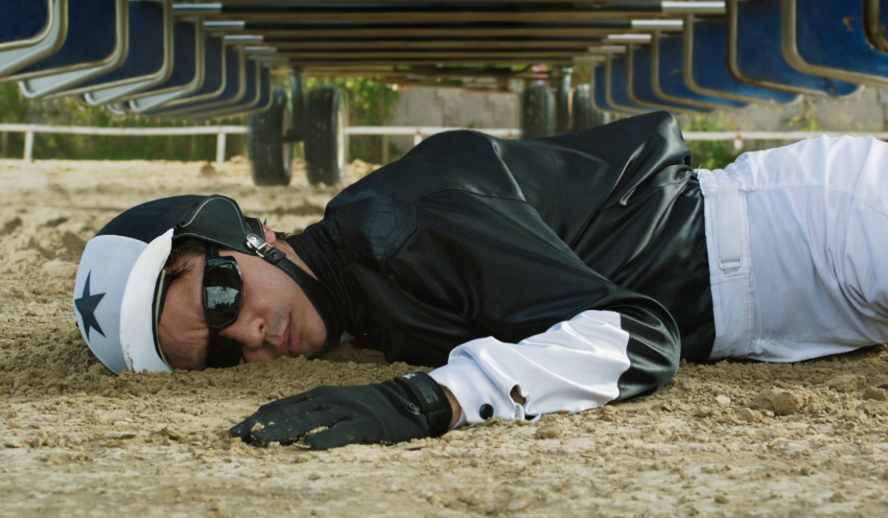The Hollywood Insider – Kill The Jockey
Luis Ortega’s latest blends crime, dark comedy, and dream logic in a visually bold story set on the fringes of Buenos Aires.
Argentinian director Luis Ortega’s ‘Kill the Jockey’, which opened in limited U.S. release on July 2nd, is not just a film; it’s an experience filled with dreamy visuals, unbridled energy of nonstop self-destruction, self-discovery, and relentless gender play. The film begins as a raw, earthy portrait of a burnt-out jockey, but finishes in a far more hypnotic place, much stranger, and ultimately much more gratifying. Ortega’s second feature feels like a fever dream filled with sweat, sequins, and cigarette smoke, where identity can feel like both prison and playground.
Luis Ortega, recognized as one of Argentina’s most courageous cinematic voices, is breaking new ground as a director with ‘Kill the Jockey’, an audacious project that has taken Ortega’s fascination for the human experience to new heights. Ortega first made waves with his 2002 debut ‘Black Box’ and gained international acclaim with ‘El Angel’ (2018). With ‘Kill the Jockey’, Ortega trades the structured contours of biography for something looser, more elusive, an operatic fever dream steeped in genre play and personal mythology. His direction is both meticulous and untethered, guiding the viewer through a labyrinth of drug-fueled decadence, fractured identities, and slippery truths. Ortega’s interest in characters who reject societal expectations in favor of self-definition resonates strongly here, reinforcing his reputation as a filmmaker less concerned with resolution than with capturing the emotional and psychological textures of transformation.
- Subscribe to The Hollywood Insider’s YouTube Channel, by clicking here.
- Limited Time Offer – FREE Subscription to The Hollywood Insider
- Click here to read more on The Hollywood Insider’s vision, values and mission statement here – Media has the responsibility to better our world – The Hollywood Insider fully focuses on substance and meaningful entertainment, against gossip and scandal, by combining entertainment, education, and philanthropy.
A Fever Dream of Self-Destruction and Reinvention
At the heart of this chaotic spiral into madness and renewal is the character of Remo Manfredini, played with captivating unpredictability by Nahuel Pérez Biscayart. A once great jockey, Remo now lives in a haze of in-between-ness, tangled in the toxic triad of as much ketamine and liquor, and self-destruction as he can accomplish. He’s not just falling, he’s hurtling through space, untethered from sobriety, responsibility, and even reality. Biscayart’s performance is the soul of the film: twitchy, aching, deadpan, and at times luminous. Remo is a paradox, a bit ghost, a bit firecracker, a man collapsing inwardly while simultaneously blowing outwardly.
During a race, Remo, drugged and barely coherent, spectacularly crashes and lands in a hospital bed with catastrophic injuries. What follows is not a conventional redemption arc but rather a radical metamorphosis. Remo flees the hospital in a stranger’s fur coat, with a bandaged head and a dazed expression. He wanders the streets of Buenos Aires like an urban ghost, or perhaps a newly hatched butterfly. Somewhere along the way, he sheds his name, becomes Dolores (or Lola), and the film itself shifts identities as well.
Related article: Why Queen Elizabeth II Is One Of The Greatest Monarchs | Her Majesty Queen Elizabeth II of United Queendom of Great Britain & Northern Ireland (Video Insight)
Related article: – Want GUARANTEED SUCCESS? Remove these ten words from your vocabulary| Transform your life INSTANTLY
Related article: ‘The Elephant Man’: Revisiting the Emotionally Genius Drama in Memory of David Lynch
Embracing the Slippery Self
Ortega doesn’t offer easy interpretations. ‘Kill the Jockey’ isn’t interested in pinning Remo’s journey to a clear psychological diagnosis or making any grand declarations about gender or identity. Instead, it embraces the slipperiness of the self. The story pulses with the dream logic of a David Lynch film but retains the playfulness of Pedro Almodóvar’s work with its more delirious moments. In fact, there’s more than a little of Almodóvar DNA in Ortega’s work, as El Angel was produced by the Spanish director’s company El Deseo.
Much of ‘Kill the Jockey’ unfolds like a series of hazy, stylized vignettes, dreamlike interludes that blur the line between reality and imagination. One moment, there’s a deliciously surreal dance number draped in bold, op-art racing silks; the next, we’re drifting through languid locker-room scenes, where jockeys flex and stretch like abstract sculptures. Cinematographer Timo Salminen lends the film a painterly texture. His high-contrast lighting and rich color palette transform Remo’s descent into a visually rich fable, one where danger, desire, and absurdity coexist in every frame.
Related article: EVOLUTION: Every Ryan Gosling Role From 1995 to 2020, All Performances Exceptionally Poignant
Related article: EVOLUTION: Every Henry Cavill Role From 2001 to 2021, All Performances Exceptionally Poignant
Related article:All Best Actor/Actress Speeches From The Beginning Of Oscars 1929-2019 | Hollywood Insider
Related article: Expected Titles at the 2025 Venice Film Festival

The Hollywood Insider – Kill The Jockey
Absurdity, Comedy, and Genre Shifting
The film is also laced with dark comedy and absurdist flourishes. Ortega switches gears, subverting genre expectations. One moment, we’re in a gangster thriller, as mob boss Sirena (Daniel Giménez Cacho) tries to manipulate Remo into racing for him again. Next, we’re in a loopy spectacle as Remo stumbles through the city, and Biscayart’s physicality grounds these tonal shifts. Whether dancing with his pregnant partner Abril (Úrsula Corberó), dodging henchmen, or staring blankly into the neon-lit void, his presence is electric.
What makes ‘Kill the Jockey’ feel so singular is how it plays with the idea of escape, not just from danger or debt, but from the self. In one scene, Remo remarks that people ride horses to arrive faster, to wage war, but mostly to escape. It’s a line that encapsulates the film’s philosophy. Every character in Ortega’s surreal Buenos Aires seems to be trying to outrun something: addiction, trauma, gender roles, and expectations. Even the secondary characters, the henchmen, Abril, and Sirena, wrestle with their own masks and desires. In this universe, no one is just one thing. Everyone is in flux.
Related article: Understanding the Star Wars Timeline
Related article: A Tribute to Francis Ford Coppola: One of Cinema’s Unforgettable Directors | ‘Megalopolis’, ‘The Godfather’ & More
Related article: #metoo Revolution: Powerful Questions That Need Answers
Related article: FACT-CHECKED Series: Timothee Chalamet and 32 Facts about The Young Superstar
Related article: Déjà View: Why Nostalgia Keeps Hollywood Repeating Itself
The Power of Ambiguity
Ortega embraces ambiguity. Is Dolores a true rebirth, or a fugue state born of trauma? Has Remo been obliterated, or merely transformed? The film doesn’t exactly tell us, because it doesn’t need to. Its power lies in its refusal to explain. ‘Kill the Jockey’ invites viewers to witness a human being come undone and reassembled, not with logic but with feeling, movement, and mood. It’s not about finding the answer; it’s about being present for the question.
Beatriz Di Benedetto’s costumes, ranging from op-art jockey uniforms to disheveled thrift store glam, further this scenic blur. The character’s outward transformation mirrors an internal conflict, and the wardrobe plays a central role in visualizing this. Meanwhile, the music, an eclectic mix of electronic beats and moody ballads, echoes Remo’s oscillating inner monologue, propelling the film’s rhythms with wit and musicality.
Related article: Top 10 South Park Characters | Who Makes the Cut? Kenny, Chef, Butters, Towelie, Eric?
Related article: In-Depth Analysis | The Unexpected Queerness of ‘Bob’s Burgers’: Why the Show is an Animated Ally
Related article: A Guide to Your Ultimate Summer Binge: Fantasy, Adventure, and Dystopian Thrills
The Beauty of Getting Lost
For those who demand clear narrative arcs or grounded realism, ‘Kill the Jockey’ might prove frustrating. But for adventurous viewers open to the bizarre and beautiful, Ortega offers a bold, captivating experience. It’s a film that doesn’t stay in its lane, because it doesn’t believe in lanes at all. It jumps the fence, abandons the track, and disappears into the night, free, messy, and magnificent.
In the end, ‘Kill the Jockey’ isn’t just about one man’s downfall or reinvention; it’s about the wild, painful, exhilarating possibility that we are never just one self. It’s about the thrill of transformation, the danger of freedom, and the strange beauty of losing your way to finally find something new.
Credits:
Director: Luis Ortega
Writers: Fabian Casas, Luis Ortega, Rodolfo Palacios
Cinematographer: Timo Salminen
Costumer: Beatriz Di Benedetto
Starring: Nahuel Pérez Biscayart, Úrsula Corberó, Daniel Giménez Cacho
By Elizabeth Gelber
Click here to read The Hollywood Insider’s CEO Pritan Ambroase’s love letter to Cinema, TV and Media. An excerpt from the love letter: The Hollywood Insider’s CEO/editor-in-chief Pritan Ambroase affirms, “We have the space and time for all your stories, no matter who/what/where you are. Media/Cinema/TV have a responsibility to better the world and The Hollywood Insider will continue to do so. Talent, diversity and authenticity matter in Cinema/TV, media and storytelling. In fact, I reckon that we should announce “talent-diversity-authenticity-storytelling-Cinema-Oscars-Academy-Awards” as synonyms of each other. We show respect to talent and stories regardless of their skin color, race, gender, sexuality, religion, nationality, etc., thus allowing authenticity into this system just by something as simple as accepting and showing respect to the human species’ factual diversity. We become greater just by respecting and appreciating talent in all its shapes, sizes, and forms. Award winners, which includes nominees, must be chosen on the greatness of their talent ALONE.
I am sure I am speaking for a multitude of Cinema lovers all over the world when I speak of the following sentiments that this medium of art has blessed me with. Cinema taught me about our world, at times in English and at times through the beautiful one-inch bar of subtitles. I learned from the stories in the global movies that we are all alike across all borders. Remember that one of the best symbols of many great civilizations and their prosperity has been the art they have left behind. This art can be in the form of paintings, sculptures, architecture, writings, inventions, etc. For our modern society, Cinema happens to be one of them. Cinema is more than just a form of entertainment; it is an integral part of society. I love the world uniting, be it for Cinema, TV, media, art, fashion, sport, etc. Please keep this going full speed.”
More Interesting Stories From The Hollywood Insider
– Want GUARANTEED SUCCESS? Remove these ten words from your vocabulary| Transform your life INSTANTLY
– A Tribute to Martin Scorsese: A Complete Analysis of the Life and Career of the Man Who Lives and Breathes Cinema
– Do you know the hidden messages in ‘Call Me By Your Name’? Find out behind the scenes facts in the full commentary and In-depth analysis of the cinematic masterpiece
– A Tribute To The Academy Awards: All Best Actor/Actress Speeches From The Beginning Of Oscars 1929-2019 | From Rami Malek, Leonardo DiCaprio To Denzel Washington, Halle Berry & Beyond | From Olivia Colman, Meryl Streep To Bette Davis & Beyond
– In the 32nd Year Of His Career, Keanu Reeves’ Face Continues To Reign After Launching Movies Earning Over $4.3 Billion In Total – “John Wick”, “Toy Story 4”, “Matrix”, And Many More

Elizabeth Gelber is an aspiring film and television producer and writer with a love for all things media, from music to fashion to entertainment. With a background in Television, Radio, and Film, as well as Fashion Communications, she is passionate about telling female-led stories that empower and resonate. Her work blends wit with empathy, aiming to humanize entertainment through an authentic lens. She believes the most powerful narratives are often rooted in everyday life, and she is drawn to creating media that reflects the world as it truly is, diverse, imperfect, and meaningful.



